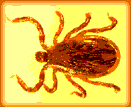There are at least 800 species of ticks worldwide. All of them are blood-feeding parasites by nature, and all follow the same life cycle: eggs are dropped between April and July, these eggs hatch into six-legged larva and
 immediately attach themselves to a rodent. Then they start to suck the rodent's
blood. Once a larval tick has secured a sizable amount of blood, it drops off its
rodent host and spends the winter on the ground. The following spring, the larva
moults, giving rise to an eight-legged nymph, which repeats the same cycle as the
larva, feeding and going to ground. The next spring, the nymph develops into an
adult and infects a large mammal (like you).
immediately attach themselves to a rodent. Then they start to suck the rodent's
blood. Once a larval tick has secured a sizable amount of blood, it drops off its
rodent host and spends the winter on the ground. The following spring, the larva
moults, giving rise to an eight-legged nymph, which repeats the same cycle as the
larva, feeding and going to ground. The next spring, the nymph develops into an
adult and infects a large mammal (like you).
 Ticks pose many dangers to humans, ranging in severity from minor irritation to
death. A localized tick infection can cause inflammation, irritation, and
trauma--all considered to be relatively mild and easily treatable. More serious
things will happen if the tick's secretions prove toxic to your body chemistry.
Ticks pose many dangers to humans, ranging in severity from minor irritation to
death. A localized tick infection can cause inflammation, irritation, and
trauma--all considered to be relatively mild and easily treatable. More serious
things will happen if the tick's secretions prove toxic to your body chemistry. In these instances, you may suffer motor paralysis, respiratory and speech
difficulties, or, in extreme cases, respiratory and/or cardiac paralysis.
Finally, on the extremely serious end of the danger scale, ticks carry a huge
number of diseases, including Tick-Borne Relapsing Fever, Tularemia, Rocky
Mountain Spotted Fever, Colorado Tick Fever, and Lyme's Disease. Most of these
diseases will prove fatal if they are not treated properly.
In these instances, you may suffer motor paralysis, respiratory and speech
difficulties, or, in extreme cases, respiratory and/or cardiac paralysis.
Finally, on the extremely serious end of the danger scale, ticks carry a huge
number of diseases, including Tick-Borne Relapsing Fever, Tularemia, Rocky
Mountain Spotted Fever, Colorado Tick Fever, and Lyme's Disease. Most of these
diseases will prove fatal if they are not treated properly.

 Tick:
Tick: